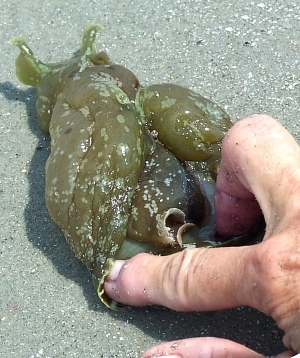Life History and Reproduction
Navigation Back to Form / Function - Home - Continue to Interactions
The sea hare actually tends to find spaces to reproduce and lay their eggs in areas that are shallower than where they live. They are more comfortable reproducing in areas that are 50cm deep. They are more attracted to areas that are sandy and shallow. At this depth in the regions they are found most in, the temperature that they are most commonly found reproducing is between 19-34 degrees Celsius. The eggs they lay have a yellowish tint to them and have a stringy look to them. When the eggs hatch, the newborns are between 6-15cm long (Tansel, Akyol 2012).

Source: http://oceanwildthings.com/2011/04/introducing-the-sea-hare/
The sea hare has been known to have had effects in the pharmacological area of study. There are compounds inside it that scientists are trying to learn more about and are trying to find more uses for them. In the digestive gland and skin of the sea hare, there are large amounts of metabolites that are believed to have been developed from the algae that they have always eaten (Farrokhnia, Nabipour, Bargahi 2012).

Source: http://www.seaslugforum.net/find/16980
Back to Form / Function - Home - Top of Page - Continue to Interactions
